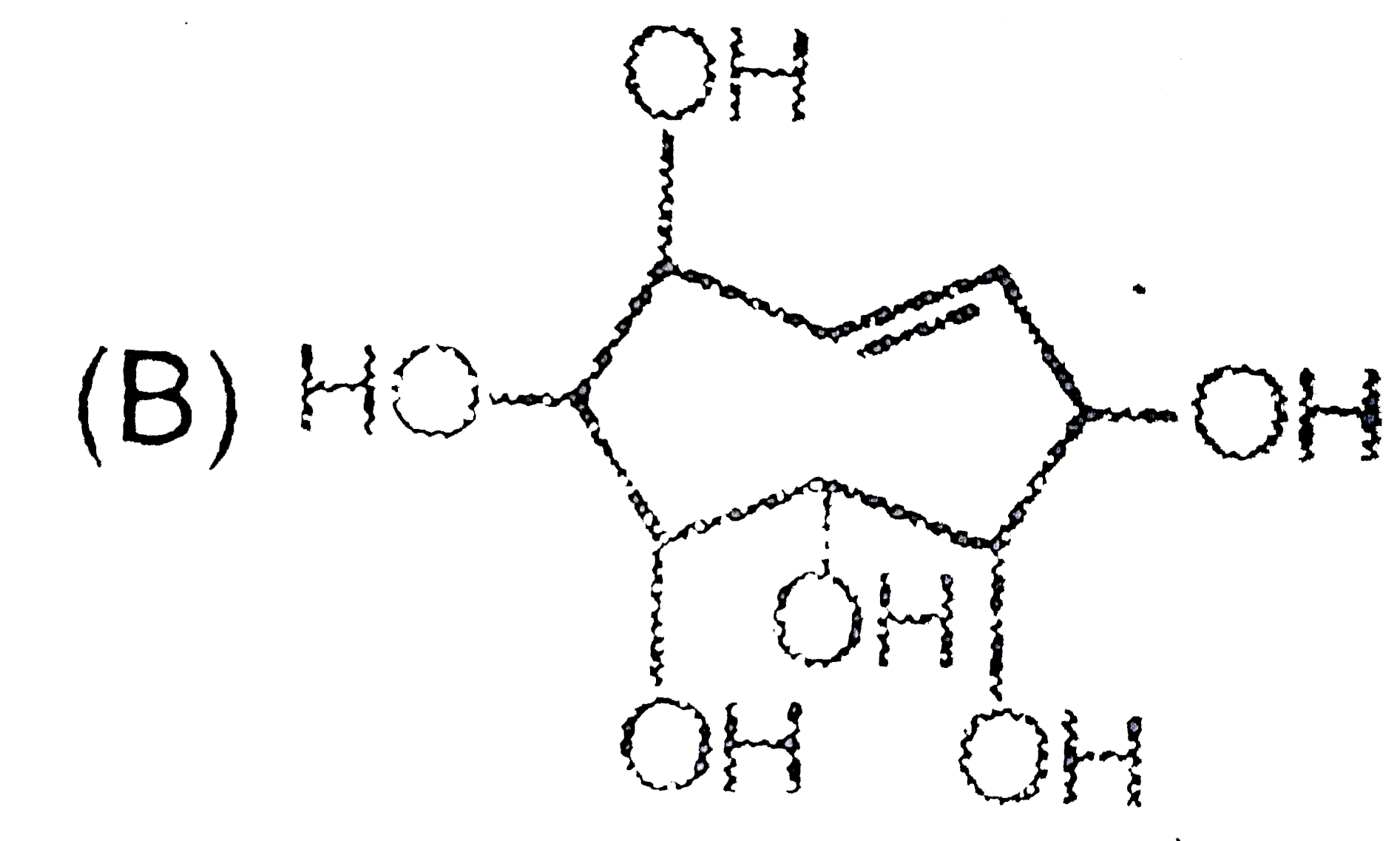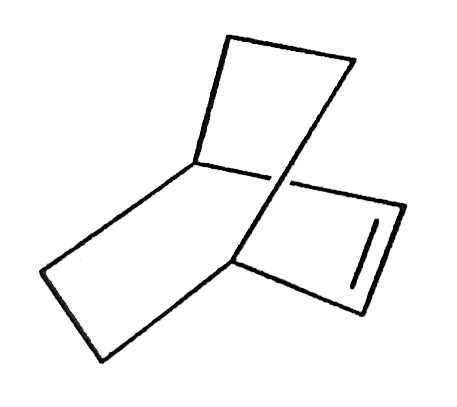C6H15O6(P)O3−−−−→Zn,H2OC4H8O4(Q)Molish−−−→reagent Violet colour ring
Structure of P connote be :
CH2∣OH−CH∣OH−CH∣OH−CH=CH−CH∣OH−CH∣OH−CH2∣OH)

CH2∣OH−CH∣OH−CH∣OH−CH=CH−CH∣OH−CH∣OH−CH=O
HOOC−CH2−CH∣OH−CH=CH−CH∣OH−CH2−COOH
The correct Answer is:B, C, D
To solve the question regarding the structure of compound P (C₆H₁₅O₆) that undergoes ozonolysis to yield compound Q (C₄H₈O₄) and gives a positive Molisch test, we can follow these steps:
1. Understanding the Reaction:
- The compound P (C₆H₁₅O₆) undergoes ozonolysis in the presence of Zn and H₂O. Ozonolysis typically cleaves double bonds in alkenes to form carbonyl compounds (aldehydes or ketones).
2. Determining the Product:
- The ozonolysis of compound P results in compound Q (C₄H₈O₄). This indicates that P must contain a structure that, when cleaved, yields a compound with the formula C₄H₈O₄.
3. Identifying the Functional Groups:
- The positive Molisch test indicates that compound Q contains an alpha-hydroxycarbonyl group (an aldehyde or ketone with an adjacent hydroxyl group). This is crucial for the identification of the structure.
4. Analyzing Possible Structures for P:
- We need to consider various structural possibilities for P that could lead to the formation of Q.
- The structure must allow for the formation of two carbonyl groups upon ozonolysis, which will then yield the product C₄H₈O₄.
5. Evaluating Given Options:
- We analyze the provided structures (A, B, C, D) to determine if they can yield C₄H₈O₄ upon ozonolysis.
- For each structure:
- Option A: If it yields C₄H₈O₄ and contains an alpha-hydroxycarbonyl, it could be a candidate.
- Option B: If it produces more than one product or does not yield the correct formula, it is not valid.
- Option C: Similar analysis as B.
- Option D: Check if it contains an acid or does not yield the expected product.
6. Conclusion:
- After evaluating all options, the correct structure for P must be one that can only yield C₄H₈O₄ and give a positive Molisch test.
- Based on the analysis, options B, C, and D do not fit the criteria, thus they cannot be the structure of P.
Final Answer:
- The structure of P cannot be options B, C, or D.
- The compound P (C₆H₁₅O₆) undergoes ozonolysis in the presence of Zn and H₂O. Ozonolysis typically cleaves double bonds in alkenes to form carbonyl compounds (aldehydes or ketones).
- The ozonolysis of compound P results in compound Q (C₄H₈O₄). This indicates that P must contain a structure that, when cleaved, yields a compound with the formula C₄H₈O₄.
- The positive Molisch test indicates that compound Q contains an alpha-hydroxycarbonyl group (an aldehyde or ketone with an adjacent hydroxyl group). This is crucial for the identification of the structure.
- We need to consider various structural possibilities for P that could lead to the formation of Q.
- The structure must allow for the formation of two carbonyl groups upon ozonolysis, which will then yield the product C₄H₈O₄.
- We analyze the provided structures (A, B, C, D) to determine if they can yield C₄H₈O₄ upon ozonolysis.
- For each structure:
- Option A: If it yields C₄H₈O₄ and contains an alpha-hydroxycarbonyl, it could be a candidate.
- Option B: If it produces more than one product or does not yield the correct formula, it is not valid.
- Option C: Similar analysis as B.
- Option D: Check if it contains an acid or does not yield the expected product.
- After evaluating all options, the correct structure for P must be one that can only yield C₄H₈O₄ and give a positive Molisch test.
- Based on the analysis, options B, C, and D do not fit the criteria, thus they cannot be the structure of P.
- The structure of P cannot be options B, C, or D.
Topper's Solved these Questions
- STRUCTURAL IDENTIFICATIONBook:RESONANCE ENGLISHChapter:STRUCTURAL IDENTIFICATIONExercise:Advanced level Problems (Part-III)
Explore 12 Videos
- STRUCTURAL IDENTIFICATIONBook:RESONANCE ENGLISHChapter:STRUCTURAL IDENTIFICATIONExercise:Advanced level Problems (Part-I)
Explore 29 Videos
- STEREOISOMERISMBook:RESONANCE ENGLISHChapter:STEREOISOMERISMExercise:EXERCISE (PART III : PRACTICE TEST-2 (IIT-JEE (ADVANCED PATTERN))
Explore 23 Videos
- SURFACE CHEMISTRYBook:RESONANCE ENGLISHChapter:SURFACE CHEMISTRYExercise:Section - 5
Explore 1 Video
Similar Questions
Knowledge Check
H3C−CH3∣C∣CH3−H+CCl4R2O2−−→hvProduct :
AH3C−CH3∣C∣CH3−ClBCHCl3CBoth (a) and (b)DNone of these
 (i)O3−−−−−−−−→(ii)Zn−H2O¯:OH−−→Δ NO. of aldol condensation product.
(i)O3−−−−−−−−→(ii)Zn−H2O¯:OH−−→Δ NO. of aldol condensation product.
View SolutionC8H10O3,H2O−−−−→C4H6O2 Acid (B), Identify (A) and (B) in the above reaction
View SolutionCH2=CH2+B2H6NaOH−−−→H2O2 Product is :
View SolutionFeO⋅Cr2O3Na2CO3−−−−→O2AH2SO4−−−→BKCl−−→C
The hybridisation of compound C and colour of its crystal is
View SolutionBut-2-ene 1.O3−−−−−−−→2.Zn,H2OPOHӨ−−−−−→ΔQPd/C−−−−−→H2R
R is :
View SolutionConsider the following reaction.
CH3O16∣∣C−O18−C2H5+H2O16H+−−→Heat
The products formed in the reaction are
View SolutionWrite the product of following reactions :
(a) CH3−H3C∣C=CH3∣C−CH3O3−−−−−→Zn/H2O , (b) CH3−C≡C−CH3O3−−−−−→Zn/H2O
( c) CH3−C≡C−CH3O3/H2O2−−−−−→ , (d) CH3−CH3∣C=CH−CH3O3/H2O2−−−−−→
View Solution
 ,
,